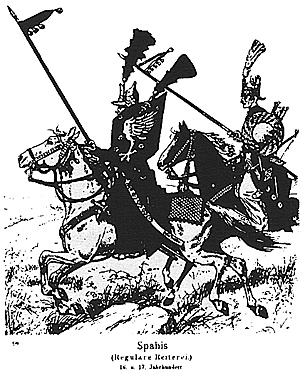 The feudal element of the Ottoman Army was composed of a nonheriditary land holding that was paid for by the military service of the holder. These lands were held directly from the Porte and thus they owed their position to the Sultan. These were divided into two different classes, dependent on the size and wealth of the holder/holding. The richer holders were named spahis (small 's' for distinction) like the Household regiment. The poorest landholders were called Tunarots. The spahis were required to provide up to 18 retainers for war, at their own expense. These retainers were known as Cebeli or Jebeli.
The feudal element of the Ottoman Army was composed of a nonheriditary land holding that was paid for by the military service of the holder. These lands were held directly from the Porte and thus they owed their position to the Sultan. These were divided into two different classes, dependent on the size and wealth of the holder/holding. The richer holders were named spahis (small 's' for distinction) like the Household regiment. The poorest landholders were called Tunarots. The spahis were required to provide up to 18 retainers for war, at their own expense. These retainers were known as Cebeli or Jebeli.
The spahis would be less well-equipped and armed than the Household Spahis, and the Timarots and Cebeli even less so. Weapons for all classes would be a light lance with a pennon, the lance usually painted green, a composite bow with quiver, sword of scimitar, a javelin or two and possibly a mace. A small shield was strapped to the left arm, usually brightly painted. Armor, when worn, was reinforced mail with a metal helmet with nasal guard. Horses could also be protected with mail, leather or laminated with plate covering for the face. Armor tended to be heavier the farther east one travelled and light or nonexistant in the west. The Turkish heavy cavalry would not be on par with its counterpart in the western armies of the period or even with that of the Persian armies. The horses were smaller in stature than those of the European cuirassier and gendarmes.
The territorial spahis were organized into regiments by geographical region. European spahis and Asian spahis were grouped separately.
The dress of the spahis was both colorful and rich. The preferred colors were scarlet, red, violet, dark blue and green. Gold and silver thread was used extensively to highlight clothing. Caftan worn over armor often had hussar style lace fronts. Trousers were baggy and boots were often dyed yellow. Turbans were white with a red or purple central cap with black feathers.
By the end of our period, the feudal spahis were all but eliminated by the granting of their fiefs to Spahis of the guard regiments, leaving only a few small Mmarots to fill the ranks. Thus the decline of the spahis was paralleled by an increasing western modernization.
Sekhans (Seymen)
The irregular forces of the Ottoman Empire were collectively known as Sekhans. The Sekhans constituted the most numerous collection of Ottoman troops. They were both mounted and on foot. Their weaponry ran the gamut from swords and shields to firearms. Over time, the weapons moved away from personal melee weapons and armor and towards the firearm, sword and pistols.
More Ottoman Turk Army of the 17th to Early 19th Century
- Introduction
The Standing Army
Feudal Hosts
Provincial Armies
Tribute States Armies and Freebooters
Battle Tactics
Back to Seven Years War Asso. Journal Vol. VII No. 2 Table of Contents
Back to Seven Years War Asso. Journal List of Issues
Back to Master Magazine List
© Copyright 1994 by James E. Purky
This article appears in MagWeb (Magazine Web) on the Internet World Wide Web.
Other military history articles and gaming articles are available at http://www.magweb.com